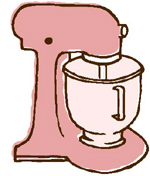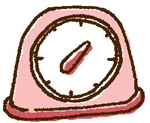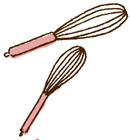Sugar Cube (4 page)
Authors: Kir Jensen

Spatulas (flexible rubber):
You’ll need a couple of these in big and small sizes for scraping down your mixing bowl, folding ingredients, etc. To be on the safe side, make sure they’re heat-proof silicone, which can withstand temperatures up to 500°F, so you can use them to cook with, too.
Spice grinder:
The blade coffee grinders sold in most kitchen supply stores can double as electric spice mills, but be sure to reserve it just for spices (or your morning cup of coffee might taste like cloves and vice versa). Grinding whole spices gives you the freshest possible flavor. Make sure to wipe out the grinder with a damp cloth between grindings, or one spice will taste like the other.
Squeeze bottle:
Plastic squeeze bottles with a narrow nozzle are great for piping decorative drizzles and swirls on your treats. You can get them cheap at restaurant supply stores, but these days most kitchen stores have them, too.

Stand mixer (preferably KitchenAid):
More powerful than a handheld mixer, this makes whipping up fluffy cake batter and sturdy cookie dough effortless. There’s really no substitute. Make sure you have the whisk, paddle, and dough hook attachments.
Thermometers:
An oven running too hot or too cold can ruin a recipe, so get an oven thermometer to make sure your oven temp is spot on. You should also have a deep-frying/candy thermometer—you really don’t want to guess with stuff like that. The old-school glass thermometers work just fine. If you want something easier to read, get a digital one.

Timer:
Even if your oven or microwave has one, you’ll need a separate timer when you’re trying to keep track of two things at once. In my early days of baking, I would have three to four timers attached to me at all times.
Tongs:
Tongs are so useful they’re like having a pair of heatproof hands. You can use them for all sorts of things, like turning donuts when deep frying. Get a pair that locks, so it’s easier to store.

Whisks:
Get a good sturdy whisk or two (it helps to have one large and one small) for blending ingredients or beating whipped cream or egg whites when you don’t want to haul out the mixer.
Wooden spoons:
They’re cheap, don’t scratch cookware, and can take a fair amount of heat. They’re also the best way to tell if a sauce or custard has thickened properly because they allow the mixture to cling a bit.

Baking dishes:
Essential sizes are 4-ounce ramekins (get at least eight); square 8-by-8-inch and rectangular 9-by-13-inch. I prefer Pyrex glass because it performs well for almost any use, and you can use it for layered creations like the
Aric-A-Strata
and
Donut-Misu
. A metal 9-by-13-inch pan is also useful as a water bath for baking delicate custards.
Baking sheets:
Rimmed baking sheets are serious workhorses, so be sure to have a bunch on hand. The most versatile size is a half sheet (18 by 13 inches). But you should have a quarter sheet, too, which is 9 by 13 inches. Make sure to get good, sturdy, heavy baking sheets in light metal. Good kitchenware stores will have them, but you can find them cheaper at a restaurant supply store.

Cake pans:
Round 8- or 9-inch pans are the most versatile standard sizes. Metal is always best. You should also have a 4-cup Bundt pan (for the
“Passions” Breakfast Bundt Cake
) and a 9-cup Bundt pan for bigger recipes; a 9-inch springform pan (which allows you to remove the sides for things like cheesecake); and a 10-inch tube pan with a removable bottom (for things like angel food cake).
Loaf pans:
Standard loaf pans are usually 9 inches long, 5 inches wide, and 3 inches deep. Be sure to have two on hand in either glass or light-colored metal (dark metal retains more heat and can lead to overbaking) for loaf cakes and quick breads. I also love the elegant shape of a long Pullman loaf pan for things like the
Le Almond
and highly recommend getting one.
Muff in pans:
Make sure that each cup has a
1
/
2
-cup capacity and that the metal is light, not dark (to prevent overbaking). A lot of cupcake and muffin recipes yield more than a dozen, so get at least two pans. Don’t bother with nonstick (which gets scratched up easily), since you’ll almost always be using muffin cup liners. I also like whoopie pie pans for baking some cookies or tea cakes, like the
Hazelnibbies
.
Pie pans:
Most pie recipes call for a 9-inch pie dish. You can get glass or metal (I prefer glass so you can see the bottom to check how the crust is browning), but make sure you get a few in different depths. For a “normal” size pie, you want a depth of 1
1
/
2
inches. For a “deep-dish” pie, the pan will need to be 2 inches deep. A
1
/
2
-inch difference may not seem like much, but the difference in volume is 3 cups. So if you don’t use the pie dish with the right depth, you might end up with way too much or way too little filling.
Pots and pans:
First, a note about metal—Aluminum and copper are great heat conductors, but they will react with acidic ingredients and may give your food a metallic taste. Copper is also very expensive and prone to tarnishing. Stainless steel won’t react, but it doesn’t conduct heat as well. That means the most versatile pans are anodized aluminum, stainless steel with an aluminum or copper core (my preference), or aluminum lined with stainless steel. No matter what brand you buy, make sure the cookware has a heavy bottom to keep things from burning and scorching. Recommended sizes are 8-inch, 10-inch, and 14-inch sauté pans, and 2-quart and 4-quart saucepans with lids. Make sure one of the saucepans is deep enough for making things that can bubble up, like caramel. I also think it’s important to have at least one cast-iron skillet (9- or 10-inch). When seasoned properly they’re nonstick, conduct heat evenly, retain heat very well, and can go in the oven. You can use them for just about anything—and they’re great for baking cornbread or tarte Tatins.
Tart pans:
Metal tart pans with a removable bottom are essential for fruit tarts and quiches, which rely on a pretty fluted crust. Get at least a 9-inch round, but 8-inch and 10-inch are also commonly used. A 4-by-13-inch rectangular tart pan is one of my favorite shapes and essential for the
Raspberry–Brown Butter–Crème Fraîche Tart
, so get one of those, too.
Now that you’ve got your baking domain properly set up, you need to stock your baking pantry. Having the most common ingredients on hand means you can make something awesome on the spur of the moment. But it’s very important to choose your ingredients wisely; they’re the building blocks of your desserts, after all. If they don’t taste good, your dessert won’t taste good, and your time, effort, and money will be wasted (plus your friends will be pissed they wasted their calories on it). As any chef will tell you, part of being a good cook is being a good shopper. So take time to choose your ingredients with care and spend a few extra pennies to get the best quality possible.
Butter:
Although I love salt and sprinkle it liberally on my desserts to bring out and support the other flavors, I always bake with unsalted butter. Every butter producer adds different amounts of salt to their salted butter, making it harder to control the saltiness of the finished product. Also, salt is a preservative, so salted butter often isn’t as fresh-from-the-dairy as unsalted butter. When choosing unsalted butter for baking, look for European-style butters, which have a higher fat content (and less water) and are often cultured so they have the slightest hint of tang. Some of my faves are Crèmerie Classic and Plugrá.
Chocolate:
There is so much wonderful, interesting, nuanced chocolate out there that it would be a crime to settle for the cheap stuff in your desserts. For milk chocolate, make sure it’s at least 41 percent cacao and comes from a quality producer, so it’ll taste like more than just milk and sugar. For semisweet and bittersweet chocolate, the higher the percentage of cacao, the more intense and less sweet the flavor will be. My target range is 69 to 74 percent. For cocoa powder, darker is better in my book, so look for cocoa powder labeled Dutch process, European, dark, or extra-brut. In terms of producers, Callebaut is a good workhorse brand from Belgium. Valrhona, Scharffen Berger, and Green & Black’s are also widely distributed brands with an emphasis on quality. There are a lot of smaller producers doing amazing stuff, too, so look around online or at a chocolate retailer like Cacao in Portland to find something new. For more on chocolate, read the sidebar in
Triple Threat Chocolate Cookies
.
Dairy:
Sour cream, cream cheese, milk … if you’re going to bake with them, you need to get the full-fat stuff. Fat equals flavor (I repeat:
Fat equals flavor!
), so don’t skimp and use low-fat or non-fat. The few extra calories you save will be to the detriment of your dessert.

